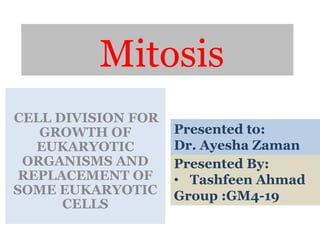
Mitosis , Cell division
- 1. Mitosis CELL DIVISION FOR GROWTH OF EUKARYOTIC ORGANISMS AND REPLACEMENT OF SOME EUKARYOTIC CELLS Presented By: • Tashfeen Ahmad Group :GM4-19 Presented to: Dr. Ayesha Zaman
- 2. What is Mitosis? • Mitosis is cell division which begins in the fertilized egg (or zygote) stage and continues during the life of the organism in one way or another. Each diploid (2n) daughter cell is genetically identical to the diploid (2n) parent cell.
- 3. Walther Flemming (1843 – 1905) • Described the process of cell division in 1882 and coined the word ‘mitosis’ • •Also responsible for the word “chromosome’ which he first referred to as stained strands • •Co-worker Eduard Strasburger named the mitotic stages ‘prophase, metaphase, anaphase, telophase’ in 1884
- 4. What is Mitosis? Walther Flemming’s book: Zellsubstans, Kern und Zelltheilung (Cell-Substance, Nucleus, and Cell- Division) Illustration showing chromosomes and the process of mitosis, 1882
- 5. DNA Replication and Cell Division
- 6. Why Do Cells Undergo Mitosis? • Mitosis is exact nuclear division. The DNA in the parent cell is copied exactly and then the cell nucleus divides exactly so each of the two daughter cells has the same kind and number of genetic base pairs arranged in chromosomes as the parent cell. • Mitosis is necessary because when cells reach a surface area to volume ratio that is too small relative to the rate of diffusion of nutrients and water into the cell, and thus the nutritional demands of the cell cannot be met. • In order to address this, the cell undergoes mitosis to form two identical, but smaller cells, which increases the surface area to volume ratio, and thus the rate of diffusion can meet the nutritional demands of the entire cell.
- 7. Interphase • The cell prepares for division • Animal & Plant Cell – DNA replicated (copied) – Makes new organelles (synthesis) – Cell increases in size (growth)
- 8. The Stages of Interphase and Cell Division
- 10. Prophase • The cell prepares for nuclear • Animal & Plant Cell – Chromosomes appear – Centrioles separate & spindles form – Nuclear envelope disappears – LONGEST phase in mitosis
- 12. Metaphase • The cell prepares chromosomes for division • Animal & Plant Cell – Chromosomes line up at the middle of the cell – Spindle fibers attach to chromosomes at the centromere – SHORTEST phase of mitosis
- 14. Anaphase • The chromosomes divide • Animal & Plant Cell – Spindle fibers pull chromosomes apart – ½ of each chromosome (called chromatid) moves to poles of cells
- 15. Telophase • The cytoplasm divides • Animal Cell – DNA uncoils & appears as chromatin again – 2 nuclei form – Cell membrane pinches in to form the 2 new daughter cells • Plant Cell – DNA uncoils & appears as chromatin again – 2 nuclei form – New cell wall forms between two nuclei to form the 2 new daughter cells
- 16. Cytokinesis
- 17. References • http://en.wikipedia.org • https://www.boundless.com/biology/textbooks/boundless-biology- textbook/cell-reproduction-10/ the-cell-cycle-88/interphase-395- 11621/images/the-stages-of-interphase-and-the-cell-cycle/ • http://creativecommons.org/licenses/by-sa/4.0/ • http://upload.wikimedia.org/wikipedia/commons/4/43/Mitosis_dia gram.jpg • https://www.boundless.com/biology/textbooks/boundless-biology- textbook/cell-reproduction-10/the-cell-cycle-88/the-mitotic-phase- and-the-g0-phase-396-11622/images/fig-ch10_02_03 http://creativecommons.org/licenses/by-sa/4.0/
